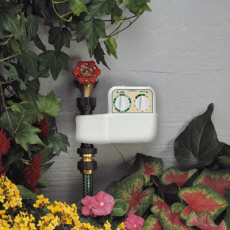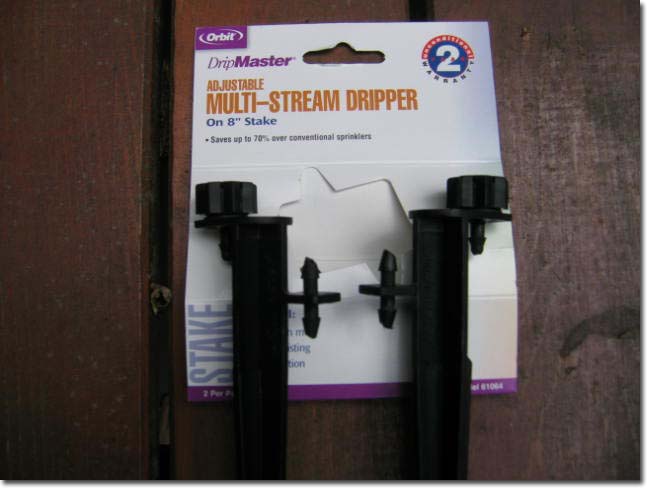On July 19, 2007 I wrote a short post on re-connecting the drip irrigation system on my deck. I was able to connect everything but because of the constant rain I didn’t need to run the system. A few weeks ago the clouds cleared and the sun came out and I was able to run the flow test and set up the automatic timer.

Here’s the irrigation timer I used for my drip irrigation system
Now I would like to discuss the steps I followed to setup the timer for the drip irrigation system. There our a few different styles of the drip irrigation timers, the one I’m using is an Orbit 91600 (picture to the right). I would classiffy this as a dial hose faucet. It connects into your hose and is very easy to setup. I picked this style because it was inexpensive, easy to use and I was only watering a few plants on our deck. Last year I watered two hanging baskets and this year I added a flower box and two large pots.
Drip Irrigation System Test:
Once the drip irrigation system is connected you need to make sure there are no leaks and the water is flowing correctly to all of your emitters. The best way to do this is turn the faucet on and then set dial “B” (duration) on your irrigation timer to “On”. This will start the system.
Once the water started you want to check the irrigation timer and connection to the hose to make sure it isn’t leaking. If it is leaking you need to tighten the connections and make sure you have a gasket at the connectors. That is the little rubber things that usually fall out that provide a good seal.
Next go to connections an make sure the water isn’t leaking. This was especially important for us because the irrigation tubing is running on our wooden deck and I don’t want the water leaking on the deck. It’s also a waste of water and if it is a big leak you may not get enough water to your plants or you will need to run the system longer so your plants get sufficient water.
Now check the emitters to make sure they are working correctly. You want ensure they are providing enough water but the water isn’t shooting outside of your container. I purchased a very cool looking lady bug emitter from Home Depot but the range was to great for the pot it was in and there was no way to adjust the water flow. I took it back and got an emitter that I could control the flow. Actually, I prefer the adustable ones so you can fine to the watering to different plant needs.

Make sure you get a few of the multi-stream drippers
For the herb container I got a package of two multi-stream stakes. The stakes are planted into the dirt and you can adust the height by how deep you bury the stakes. You can also adjust the flow of the drip by turning the dial on the top. I have the two stakes connected in-line and used a tee at the first stake to connect the second one. I had to adjust the two stakes as a system. If I decreased the water in one it would increase the water in the other one, so I had to decrease the water in this one. Since the system would be on for all of the plants for the same length of time I reduced the water as much as possible for the herb container and maximized the water in the hanging baskets. The potted plants were in the middle.

Herb container with multi-stream stakes
Here is a picture of the mult-stream stakes installed in the herb container. They are the black emitters on the left and right side of the container. Left one beside the rosemary and the right one in the thyme.
The basil is in the middle, it needs less water so I thought it best to keep it as far away from the emitters as possible. If this was a round pot I would probably only use one emitter and crank up the water flow. Right now the water is basically dripping out.
Drip Irrigation System Flow Test:
Once your system is connected you will need determine how long you should water your plants. Each plant will have different watering needs. This will also be determined based on your climate and the style of container your plant is in.
- Our hanging baskets are made of cedar and excess waters drains out of the bottom, so they should be water once a day.
- Our flower pots are ceramic and they don’t have drain holes on the bottom so I need to ensure they don’t get water logged.
- Our herbs are in a plastic style of container that hangs on the deck rail. It does have a draing hole on the bottom but herbs don’t need as much water as other plants so you need to monitor these closely.
The best time is to run this test when the containers are dry and need to be watered. You can do this as part of the system test above or you can run the test on the following day. For our watering needs to I decided to run the system once a day. Based on your plants and local climate you might want to run it more often.
This test is pretty simple:
- Check the time or start a stop watch
- Turn your system on and monitor your plants
- When your plants have had enough water turn the water off and check the time, for my system it was 10 minutes
Now you know how long you should run your irrigation timer and system for each day.
Setting the Irrigation Timer:
The details for setting up your irrigation timer might be a different than the Orbit 91600 but they will probably be similar to the following:
- Turn the water on at your faucet
- Set Dial B to “Off”
- Set Interval Dial A to “Daily” – will water once a day
- Set the Duration on Dial B to “10 min” – this is based on the System Flow Test above
Note the following for the timer I used:
- If the interval is set to Once the watering will start in 24 hours from the time you set up the timer. If you want your watering to start early in the morning you will need to set it up early in the morning.
- The watering will start after the first interval…this will most likely be the next day. I sat there for a few minutes wondering why it wasn’t watering. I set it up a second time and then finally read the manual to figure that one out 🙂
- If you turn the water off you will need to reset the timer. This is where having a hose Y with individual shut off valves is a good idea. You can still use your tap for other things and keep your system up and running.
Well that’s it. I hope this post helps you set up your own drip irrigation system. Once it is installed it will save you time and your plants will be promptly watered every day.
Speak Your Mind